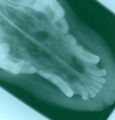| This article is still under construction. |
Description
Aspergillosis is a disease of the respiratory system caused by several Aspergillus spp. A. fumigatus is the most frequently reported species in domestic animals. Commonly affected species include birds, dogs, cats, horses and cattle but the disease has been reported in many other wild and domestic species.
Clinical signs
Birds
In avian species the disease manifests as a diffuse infection of the air sacs. Two forms of the disease have been reported; a diffuse pneumonic form and a nodular form involving the lungs. Clinical signs include diarrhoes, listlessness, pyrexia, loss of appetite and loss of condition. Seizures may occasionally occur.
Cattle
Infection in cattle may cause abortion and ocular infections. Infections involved the uterus, foetal membranes and foetal skin. Lesions are usually up to 2mm in diameter and contain asteroid bodies with a germinated spore in the centre. Acute infection causes miliary lesions and chronic infections causes granulomatous and calcified lesions.
Horses
In the horse the guttural pouches are most commonly affected. Aspergillus infection may also lead to abortion.
Dogs, cats and sheep
Infections occur, but infrequently in these animals. The lungs and nasal cavity are most commonly affected. Dogs
- Disseminated form with granulomas and infarcts can occur in dogs
- Pulmonary and intersitital forms can occur in cats
- Humans:
- Grows on Sabauraud's Dextrose and Blood agar
- White colonies intitially which turn green, then dark green, flat and velvety
- Colony colour varies with species
- Also grows on Czapek-Dox agar and 2% malt extract agar supplemented with antibacterial antibiotics
- Microscopically:
- Conidiophores with large terminal vesicles (only visible in the lungs and air sacs where there is access to oxygen)
- Vesicle shape varies depending on the species
- Is a common contaminant so repeated tests should be done for a definitive diagnosis
- Conidiophores with large terminal vesicles (only visible in the lungs and air sacs where there is access to oxygen)
- Serology:
- Gel immunodiffusion for canine nasal asper
- Treatment:
- Surgery
- Antifungal drugs
- Pathology:
- Aspergillus fumigatus causes rhinitis, respiratory tract inflammation and sinusitis
- Sometimes appears on lesions of ethmoidal haematoma
Aspergillus fumigatus
- Aspergillus fumigatus
- Most commonly in dogs but also other species
- Causes rhinitis, often also involves the frontal sinus
- Chronic necrotising inflammation with friable exudate containing necrotic tissue and fungal hyphae
- Result in severe neutrophilic rhinitis/sinusitis
- These lesions can be aggressive causing destruction of turbinates and nasal septum
- Can occur secondary to areas of mucosal compromise eg: adjacent to a space-occupying lesion
- Can cause pulmonary aspergillosis especially in birds, but also other animals
- Initiated by inhalation of spores,the most likely source of which is mouldy feed and bedding
- Given the wide exposure that occurs, it is thought that immunodeficiency may contribute to colonisation with this organism
- Gross lesions :
- Multiple discrete grey/ white nodules which develop around fungal colonies
- Blood vessels can become involved in the lesions -> invasion, haemorrhage or thrombosis
- Histologically:
- Granulomatous chronic lesions
- Macrophages and epithelioid cells
- Fibrous capsule
- In horses:
- Nasal aspergillosis
- Guttural pouch infections in horses - fungal plaques form on the adventitia of the carotid arteries can lead to catastrophic haemorrhage following erosion of carotid arteries!
- Often present with epistaxis
- May present with neurological dysfunction
- Rarely extends to other resions: cranium, middle ear, atlanto-occipital joint
- May extend to sinuses










